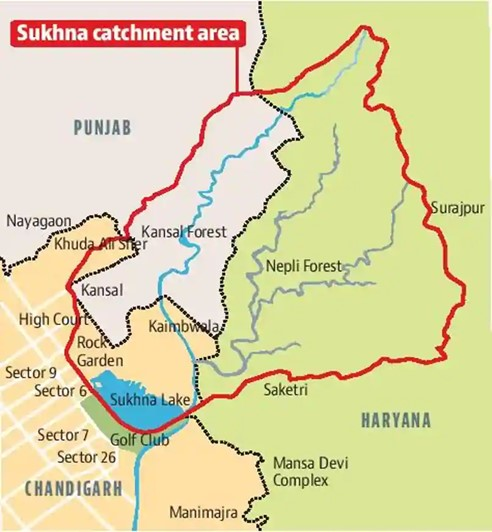Haryana Switch to Hindi
Sukhna Lake Declared Eco-Sensitive Zone
Why in News?
Recently, The Union Ministry of Environment, Forest and Climate Change, declared an area from 1 km to 2.035 km around the Sukhna Wildlife Sanctuary as an Eco-Sensitive Zone (ESZ) in Panchkula district, Haryana for the purpose of preventing, controlling and abating environment pollution.
Key Points
- The total area of the ESZ covers a total of 24.60 sq km.
- Prohibited and Regulated Activities in ESZ:
- Activities are regulated under the Environment (Protection) Act, 1986.
- Prohibited Activities:
- About Sukhna Wildlife Sanctuary:
- The Sukhna Wildlife Sanctuary, spread over 25.98 square km (about 6420 acres), is under the administrative control of the Union territory of Chandigarh and shares its boundaries with Haryana and Punjab.
- The sanctuary is located in the Shivalik foothills, which are considered ecologically sensitive and geologically unstable.
- It is home to at least seven Schedule 1 animal species of the Wildlife Act, 1972, including leopard, Indian pangolin, sambar, golden jackal, king cobra, python, and monitor lizard.
- The Schedule 1 species are considered endangered and in need of immediate protection.
- Besides, there are Schedule 2 animal species like reptiles, butterflies, trees, shrubs, climbers, herbs, and 250 bird species that inhabit the sanctuary.
- In 2020, the Punjab and Haryana High Court declared Sukhna Lake a "living entity" and directed the Environment Ministry to establish at least a 1 km ESZ from the sanctuary’s boundary in Punjab and Haryana.
Eco Sensitive Zones (ESZ)
- The National Wildlife Action Plan (2002-2016) of the Ministry of Environment, Forest and Climate Change (MoEFCC) stipulated that state governments should declare land falling within 10 km of the boundaries of national parks and wildlife sanctuaries as eco-fragile zones or Eco-Sensitive Zones (ESZs) under the Environmental (Protection) Act, 1986.
- While the 10-km rule is implemented as a general principle, the extent of its application can vary. Areas beyond 10 km can also be notified by the Union government as ESZs, if they hold larger ecologically important “sensitive corridors”.








%20MPPCS%202025%20Desktop%20E.jpg)
%20MPPCS%202025%20Mobile%20E%20(1).jpg)










.png)
.png)











 PCS Parikshan
PCS Parikshan


